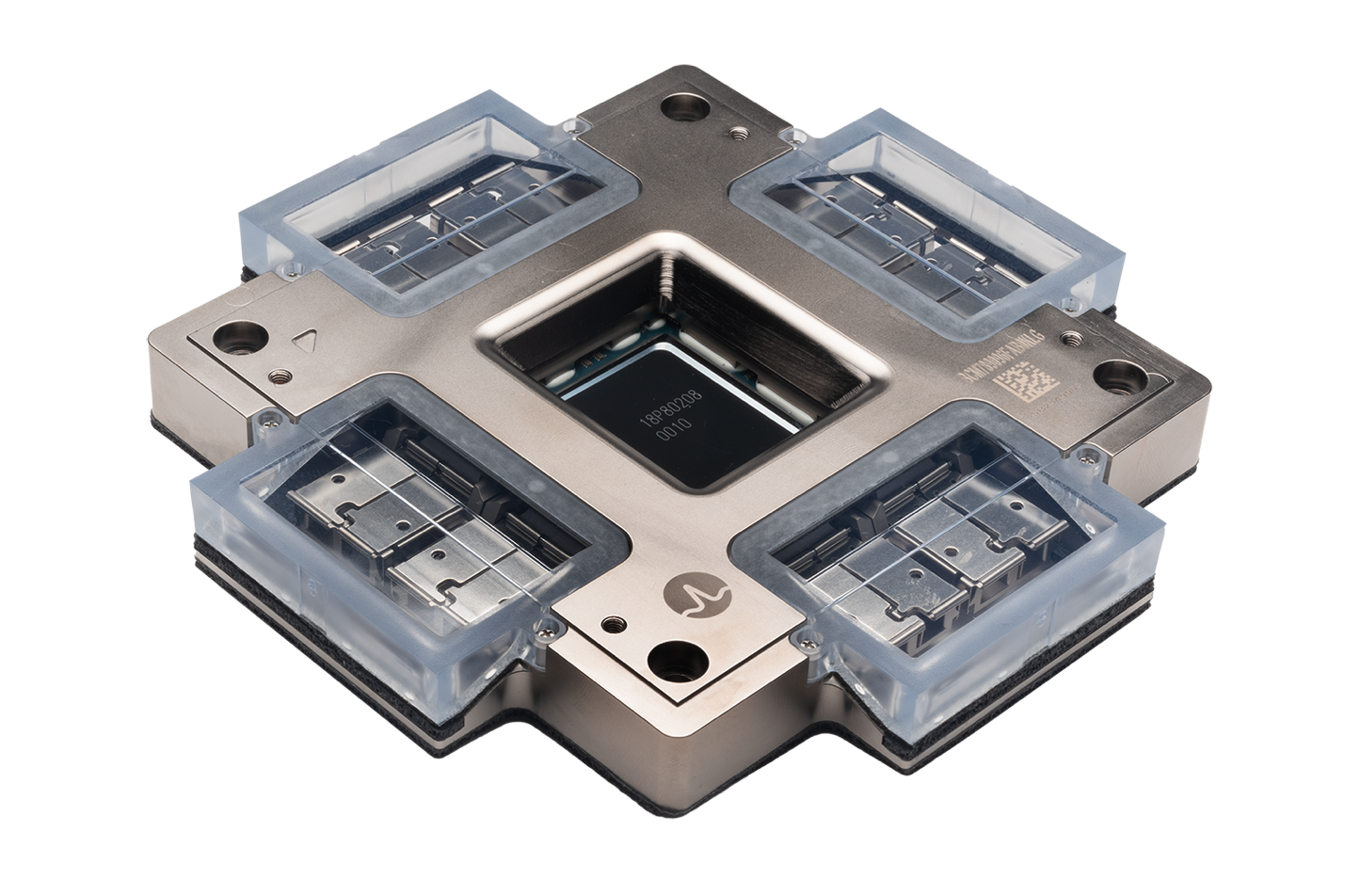Introduction: A New Chapter in Optical Connectivity
Introduction: A New Chapter in Optical Connectivity
In January 2021, Broadcom CEO Hock Tan introduced Co-Packaged Optics (CPO) to the world at the J.P. Morgan Auto/Tech Forum, calling it a disruptive leap in networking. Just a few years later, CPO has moved from concept to real-world demo, including Broadcom’s latest showcase at OFC 2025, featuring the industry’s first 6.4 Tbps optics integration for custom AI accelerators (XPU).
Co-Packaged Optics isn’t just another incremental upgrade. It represents a fundamental rethinking of how data moves inside high-performance computing systems. As AI, machine learning, and hyperscale workloads continue to stretch the limits of power, cooling, and signal integrity, CPO offers a path forward that removes inefficiencies at the silicon level.
What Is Co-Packaged Optics (CPO)?
CPO is a network architecture that integrates optical transceivers directly into the same physical package as a switch ASIC or compute processor. Instead of relying on electrical signaling to connect to an external pluggable transceiver, CPO brings the optical interface right to the edge of the chip.
This eliminates the high-speed electrical I/O bottlenecks that have traditionally introduced latency, consumed excessive power, and limited bandwidth scaling. In short, CPO shrinks the path between silicon and light, creating a faster, cooler, and more efficient interconnect.

Source: Broadcom. Illustration of traditional switch I/O vs. CPO integrated design
Why CPO Matters
The growing demands on data centers have exposed the limitations of traditional interconnects:
- Power Consumption: As data rates climb to 800G and 1.6T, power used by electrical I/O and transceivers is no longer sustainable.
- Signal Integrity: High-speed signals degrade rapidly over PCB traces, requiring complex re-timers and DSPs that add latency and cost.
- Rack Density: Every port adds heat, complexity, and physical footprint, limiting how much bandwidth you can deliver per RU.
CPO solves these problems at the source by collapsing the connection between switch and optics, reducing energy loss and enabling denser, more scalable fabric architectures.
The Promise of CPO
Broadcom and other industry leaders are positioning Co-Packaged Optics as a breakthrough solution that addresses multiple bottlenecks in high-performance compute and AI environments. According to Broadcom, CPO delivers key system-level advantages:
- Power Efficiency: Achieves up to 30% reduction in power consumption compared to DSP-based pluggable optics by eliminating unnecessary electrical interfaces. By removing unnecessary electrical hops, CPO reduces interconnect power (as low as sub-1 pJ/bit)
- Bandwidth Density: Enables up to 1 Tbps per millimeter of die edge bandwidth density, maximizing throughput in compact silicon footprints. Enabling terabit-per-mm bandwidth scaling at the chip edge
- Lower Optics Cost per Bit: Reduces cost per bit by up to 40%, enabled by simplified optics integration and component elimination. Fewer components, shorter signal paths, and simpler cooling design reduce overall cost at hyperscale
- Optimized for AI Infrastructure: Supports scale-up fabric connectivity for GPU and custom AI accelerators, critical for emerging AI workloads. CPO supports scale-up infrastructure for GPU/AI accelerators, enabling tightly coupled high-speed compute fabrics
The Challenges Ahead
While the vision is compelling, CPO introduces new engineering, and general market hurdles that must be addressed for it to scale beyond niche or hyperscale environments:
- Thermal Management: Integrating optics with ASICs concentrates heat in a very small area. This requires highly efficient and potentially novel cooling strategies to ensure performance and longevity.
- Manufacturing Complexity: Aligning and packaging optical and electrical components within the same package demands extremely precise fabrication, which could drive up production costs and slow availability.
- Repairability and Maintenance: Because the optics are built into the switch package itself, replacing failed components isn’t as simple as swapping a module. Failures could mean replacing the entire switch unit, adding risk and downtime.
- Ecosystem Maturity: CPO requires a shift in how systems are designed, tested, and supported. Standards, interoperability, and tooling are still maturing, which may create integration challenges across vendors.
- Market Adoption: No matter how promising a technology may be, market adoption is unpredictable. Many factors influence uptake, from perceived value to operational disruption. Even with clear benefits, the industry may move slowly, and broad adoption is never guaranteed.
These challenges highlight the complexity of bringing a disruptive technology like CPO into mainstream data center deployments. It’s important to distinguish between technological promise and the realities of integration, adoption, and operations.
Who Should Care, and Why
CPO is not a niche technology. Its implications stretch across the entire data infrastructure stack. Here’s who should be paying attention:
- Hyperscale Operators: If you're scaling massive AI training clusters, CPO could define your interconnect future.
- AI/ML Hardware Teams: Co-packaged optics are critical for scale-up fabric between accelerators.
- Network Architects: CPO reshapes assumptions about port density, cabling, and switch layout.
- Hardware Vendors & OEMs: Next-gen switch designs must account for optical integration from day one.
- Enterprise IT Leaders: You may not deploy CPO tomorrow, but understanding the trend informs refresh planning for 2026-2030.
What’s Next?
CPO is already being demonstrated at scale by leaders like Broadcom, NVIDIA, and Ayar Labs. Expect early deployments to expand in AI infrastructure, cloud core fabrics, and custom accelerator backplanes.
The next 3-5 years will likely see hybrid systems emerge, blending pluggables and co-packaged optics in tiered designs. Full adoption will depend on standardization, cost curve optimization, and continued industry collaboration.
Conclusion: A Technology Worth Watching
Co-Packaged Optics is no longer a theoretical concept, but its future is still unfolding. While early demos and prototypes are promising, the road to mainstream adoption remains uncertain. Like many technologies before it, CPO could redefine infrastructure or it could remain specialized, depending on how technical and economic challenges play out.
For infrastructure teams and decision-makers, understanding the fundamentals of CPO now creates a knowledge advantage. Whether or not it becomes the dominant architecture, it represents a meaningful step in the ongoing evolution of high-performance interconnects.
Recent Posts
Introduction: A New Chapter in Optical Connectivit
Low-loss fiber connectivity is essential for...
Starting a data center hardware upgrade is a...
Posts by Tag
- data center (12)
- Fiber Optic Cables (11)
- Cabling (7)
- NETWORKING (6)
- Structured Cabling (6)
- Fiber Optic Cabling (5)
- Fiber Cable (4)
- Networking Cables (4)
- Fiber Cables (3)
- Hardware Security (2)
- IT Infrastructure (2)
- Port Replication (2)
- Sustainability (2)
- AI (1)
- Brocade (1)
- Carbon Offsetting (1)
- Data Security (1)
- FCOE Works (1)
- ICLs (1)
- IT Equipment (1)
- IT Network (1)
- IT infrastructures (1)
- POE (1)
- Switches (1)
- Tapped Holes (1)
- data centers (1)
- hardware (1)
- infrastructure (1)
- storage (1)
- strategy (1)
Popular Posts
Why does the gauge matter in my network’s racks?...
High dB loss in fiber optic cabling...
Let’s look at the construction of fiber optic...








